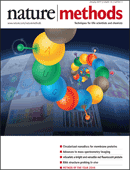Advertisement |  | Say goodbye to sore thumbs with a $3,000 pipetting robot!
Join the hundreds of labs, including Stanford, Harvard, and Mayo Clinic using Opentrons liquid-handling robots for workflow automation. It is as easy as downloading a protocol, loading your deck, and hitting run.
Click here to learn more about our personal pipetting robots, starting at $3,000. |  | | |  |  | TABLE OF CONTENTS
| January 2017 Volume 14, Issue 1 |  |  |  |  |  In This Issue In This Issue
 Special Feature Special Feature
 Editorial Editorial
 This Month This Month
 Correspondence Correspondence
 Research Highlights Research Highlights
 News Feature News Feature
 Commentary Commentary
 Review Review
 Methods to Watch Methods to Watch
 Technology Feature Technology Feature
 Brief Communications Brief Communications
 Articles Articles | |  | |  |  |
Advertisement |  | Nature Index Collaborations 2016
Institutions and countries responsible for some of the highest quality of science research tend to form the strongest alliances and partnerships. Nature Index 2016 Collaborations takes closer look at the most fruitful collaborations; such as the bond between China and the United States.
Access this free supplement for six! |  | | |  | | | | Advertisement |  | CRISPR Calendar 2017
To celebrate the continuing rise to fame of the CRISPR system, the Nature Reviews Genetics 2017 CRISPR calendar highlights the underlying biology of CRISPR, as well as its diverse range of exciting potential applications in genetic research, biotechnology and therapeutics.
Download the calendar free online
Produced with support from
OriGene |  | | |  | | | In This Issue |  Top Top |  |  | In This Issue
|  | Special Feature |  Top Top |  |  |  |  | | | | Epitranscriptome analysis is our choice for Method of the Year 2016. A News Feature looks at the history of the field, from the first discoveries of RNA modifications in the 1960s to recent transcriptome-wide methods. A Review describes the strengths and weaknesses of these methods, and a Commentary discusses the functional importance of a particular modification in stem cells. Our choice of eight methods to watch highlights areas we think will be influential in 2017 and beyond. | |
|
 |
 |
Editorial |  Top Top |
 |
 |
 |
Special Feature: Method of the Year 2016
Method of the Year 2016: Epitranscriptome analysis p1
doi:10.1038/nmeth.4142 |
 |
This Month |  Top Top |
 |
 |
 |
Points of significance: P values and the search for significance pp3 - 4
Naomi Altman and Martin Krzywinski
doi:10.1038/nmeth.4120 |
 |
Correspondence |  Top Top |
 |
 |
 |
Quantitative predictions of protein interactions with long noncoding RNAs pp5 - 6
Davide Cirillo, Mario Blanco, Alexandros Armaos, Andreas Buness, Philip Avner et al.
doi:10.1038/nmeth.4100 |
 |
Research Highlights |  Top Top |
 |
 |
 |
|
 |
News Feature |  Top Top |
 |
 |
 |
Special Feature: Method of the Year 2016
Epitranscriptomics: mixed messages pp15 - 17
Michael Eisenstein
doi:10.1038/nmeth.4125 |
 |
Commentary |  Top Top |
 |
 |
 |
Special Feature: Method of the Year 2016
Reversible RNA modifications in meiosis and pluripotency pp18 - 22
Arne Klungland, John Arne Dahl, Gareth Greggains, Peter Fedorcsak and Adam Filipczyk
doi:10.1038/nmeth.4111 |
 |
Review |  Top Top |
 |
 |
 |
Special Feature: Method of the Year 2016
Epitranscriptome sequencing technologies: decoding RNA modifications pp23 - 31
Xiaoyu Li, Xushen Xiong and Chengqi Yi
doi:10.1038/nmeth.4110
This Review describes the latest methods for profiling common epitranscriptomic marks, their scale, resolution and ability to quantify. It also discusses remaining challenges. |
 |
Methods to Watch |  Top Top |
 |
 |
 |
Special Feature: Method of the Year 2016
Global metabolomics p32
Allison Doerr
doi:10.1038/nmeth.4112
The ability to measure the metabolome on a global scale lags behind other omics techniques. |
 |
 |
 |
Special Feature: Method of the Year 2016
Expansion microscopy p32
Rita Strack
doi:10.1038/nmeth.4113
The changing face of super-resolution imaging |
 |
 |
 |
Special Feature: Method of the Year 2016
CRISPR targets RNA p33
Nicole Rusk
doi:10.1038/nmeth.4114
Having revolutionized DNA editing, CRISPR turns to RNA. |
 |
 |
 |
Special Feature: Method of the Year 2016
How single cells do it p33
Tal Nawy
doi:10.1038/nmeth.4119
Single-cell sequencing is poised to elucidate how cells contribute to tissue function. |
 |
 |
 |
Special Feature: Method of the Year 2016
Cryo-electron tomography p34
Allison Doerr
doi:10.1038/nmeth.4115
Cryo-electron tomography may facilitate in situ structural biology on a proteomic scale. |
 |
 |
 |
Special Feature: Method of the Year 2016
Faster brain imaging p34
Nina Vogt
doi:10.1038/nmeth.4118
Higher volumetric imaging rates shed light on the dynamics in neuronal networks. |
 |
 |
 |
Special Feature: Method of the Year 2016
Capturing microbial interactions p35
Tal Nawy
doi:10.1038/nmeth.4117
New approaches will expose microbial dependencies and environmental interactions. |
 |
 |
 |
Special Feature: Method of the Year 2016
Organoid culture p35
Natalie de Souza
doi:10.1038/nmeth.4122
Ex vivo organoid culture could revolutionize biology, but variability must be understood. |
 |
Technology Feature |  Top Top |
 |
 |
 |
Microbiology: the return of culture pp37 - 40
Vivien Marx
doi:10.1038/nmeth.4107
Sequencing technology drives microbiology and gives researchers new reasons to draw on classic techniques. |
 |
Brief Communications |  Top Top |
 |
 |
 |
Photometry unlocks 3D information from 2D localization microscopy data pp41 - 44
Christian Franke, Markus Sauer and Sebastian van de Linde
doi:10.1038/nmeth.4073
Three-dimensional localization microscopy can yield important biological insights. A photometric approach is described that allows users to gain 3D information from existing 2D images and to improve axial resolution obtained with existing biplane setups. |
 |
 |
 |
A statistical test for conserved RNA structure shows lack of evidence for structure in lncRNAs pp45 - 48
Elena Rivas, Jody Clements and Sean R Eddy
doi:10.1038/nmeth.4066
A new method, R-scape, tests whether observed sequence covariation supports a conserved secondary structure in RNA. The program finds no evidence for previously proposed conserved secondary structures in several lncRNAs. |
 |
 |
 |
Covalently circularized nanodiscs for studying membrane proteins and viral entry pp49 - 52
Mahmoud L Nasr, Diego Baptista, Mike Strauss, Zhen-Yu J Sun, Simina Grigoriu et al.
doi:10.1038/nmeth.4079
Membrane proteins can be stabilized in a native-like setting using lipid-bilayer-based nanodiscs encircled by a membrane scaffold protein. Covalently circularized nanodiscs now offer enhanced stability and control over nanodisc diameter size, improving the quality of structural data. |
 |
 |
 |
mScarlet: a bright monomeric red fluorescent protein for cellular imaging pp53 - 56
Daphne S Bindels, Lindsay Haarbosch, Laura van Weeren, Marten Postma, Katrin E Wiese et al.
doi:10.1038/nmeth.4074
An extremely bright, truly monomeric RFP, mScarlet, is described that outperforms existing RFPs in diverse labeling applications, especially in FRET with ratiometric imaging. |
 |
 |
 |
FDR-controlled metabolite annotation for high-resolution imaging mass spectrometry pp57 - 60
Andrew Palmer, Prasad Phapale, Ilya Chernyavsky, Regis Lavigne, Dominik Fay et al.
doi:10.1038/nmeth.4072
The authors present a computational framework for false-discovery-rate-controlled metabolite annotation from high-resolution imaging mass spectrometry data. |
 |
 |
 |
A scored human protein-protein interaction network to catalyze genomic interpretation pp61 - 64
Taibo Li, Rasmus Wernersson, Rasmus B Hansen, Heiko Horn, Johnathan Mercer et al.
doi:10.1038/nmeth.4083
InWeb_InBioMap (InWeb_IM for short) is a scored, integrated human protein-protein interaction network resource aggregated from public, experimentally determined protein-protein interactions. The resource enables functional interpretation of large-scale genomics data. |
 |
 |
 |
novoBreak: local assembly for breakpoint detection in cancer genomes pp65 - 67
Zechen Chong, Jue Ruan, Min Gao, Wanding Zhou, Tenghui Chen et al.
doi:10.1038/nmeth.4084
The novoBreak software provides sensitive, accurate, and comprehensive detection of structural variation in somatic next-generation sequencing data. |
 |
 |
 |
TACO produces robust multisample transcriptome assemblies from RNA-seq pp68 - 70
Yashar S Niknafs, Balaji Pandian, Hariharan K Iyer, Arul M Chinnaiyan and Matthew K Iyer
doi:10.1038/nmeth.4078
TACO generates a consensus transcriptome with improved accuracy from multisample RNA-seq data. |
 |
 |
 |
CHARMM36m: an improved force field for folded and intrinsically disordered proteins pp71 - 73
Jing Huang, Sarah Rauscher, Grzegorz Nawrocki, Ting Ran, Michael Feig et al.
doi:10.1038/nmeth.4067
An all-atom protein force field, CHARMM36m, offers improved accuracy for simulating intrinsically disordered peptides and proteins. |
 |
Articles |  Top Top |
 |
 |
 |
DMS-MaPseq for genome-wide or targeted RNA structure probing in vivo pp75 - 82
Meghan Zubradt, Paromita Gupta, Sitara Persad, Alan M Lambowitz, Jonathan S Weissman et al.
doi:10.1038/nmeth.4057
DMS-MaPseq enables genome-wide and target-specific RNA secondary structure probing of even rare or heterogeneously structured RNAs in vivo and was used to study structure involved in translation regulation as well as nascent transcripts. |
 |
 |
 |
Robust statistical modeling improves sensitivity of high-throughput RNA structure probing experiments pp83 - 89
Alina Selega, Christel Sirocchi, Ira Iosub, Sander Granneman and Guido Sanguinetti
doi:10.1038/nmeth.4068
BUM-HMM is a statistically robust modeling pipeline for interpreting high-throughput RNA structure probing data, including that from transcriptome-wide experiments. |
 |
 |
 |
Atmospheric pressure MALDI mass spectrometry imaging of tissues and cells at 1.4-μm lateral resolution pp90 - 96
Mario Kompauer, Sven Heiles and Bernhard Spengler
doi:10.1038/nmeth.4071
An instrumental setup for atmospheric pressure MALDI-based mass spectrometry imaging with improved lateral resolution enables subcellular-level details to be resolved. |
 |
 Top Top |
 |
 |
 |  |  |  |  |  | Natureevents is a fully searchable, multi-disciplinary database designed to maximise exposure for events organisers. The contents of the Natureevents Directory are now live. The digital version is available here.
Find the latest scientific conferences, courses, meetings and symposia on natureevents.com. For event advertising opportunities across the Nature Publishing Group portfolio please contact natureevents@nature.com |  |  |  |  |  |
|
 |


No comments:
Post a Comment